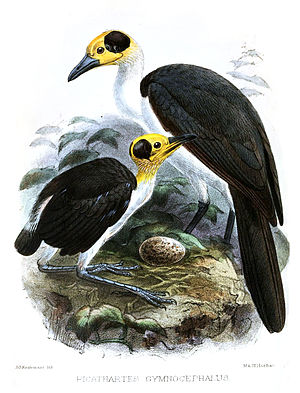Rockhopper
| Rockhopper | ||||||||||||
|---|---|---|---|---|---|---|---|---|---|---|---|---|

Yellow-headed rockhopper ( Picathartes gymnocephalus ) |
||||||||||||
| Systematics | ||||||||||||
|
||||||||||||
| Scientific name of the family | ||||||||||||
| Picathartidae | ||||||||||||
| Lowe , 1938 | ||||||||||||
| Scientific name of the genus | ||||||||||||
| Picathartes | ||||||||||||
| Lesson , 1828 |
The rock hoppers ( Picathartes ), also called stilt crows , form a genus in the family of the same name rock hoppers (Picathartidae) within the order of the passerine birds (Passeriformes). The genus includes two types.
Occurrence
Both species live in the tropical rainforests of West Africa and Central Africa . The yellow-headed rockhopper is widespread from Guinea and Sierra Leone to Togo , the bunt-headed rockhopper from southern Cameroon to northern Nigeria . In Ghana , the yellow-headed rockhopper is under nature protection , as the population has decreased significantly due to forest clearing, wild catches from zoos or collectors.
features
They have long tails, a raven-like black beak, strong long legs and feet, and are relatively large at 38 to 40 centimeters. The plumage of the yellow-headed rockhopper is dark to light gray on the upper side; white on the underside. The head is bare and yellow. The two black spots on each side on the back of the head are characteristic. The upper plumage of the Buntkopf Felshüpfer is dark to light gray; the underside is white. The head is bare, light blue on the front and a crimson color on the back. The Buntkopf Felshüpfer also has black spots on each side of the back of the head.
nutrition
The rock hoppers feed on insects , snails and other small invertebrates, which they track down by hopping on the forest floor. They also occasionally eat frogs and mice . When hunting, they jump up to a meter without the help of their wings. They often follow the wandering ants and devour the startled insects.
Reproduction
Rockhoppers are colony breeders. The cup-shaped nests are built from mud or clay and attached to the walls of rock caves or to overhanging rocks on a cliff. The walls are strengthened with plant fibers and grasses. The inside of the nest is padded with plant fibers and grass. Two eggs are laid in the nests, which are hatched over a period of 20 to 22 days.
Systematics
The taxonomic classification of rock hoppers was long considered controversial. They were initially considered to be crows related and classified into the Corvidae family . In 1938 Percy Roycroft Lowe created the subfamily Picatharninae and saw the rockhoppers as a genus within the starling family . In 1951, Jean Delacour and Dean Amadon concluded that the rockhoppers are more closely related to the timalia than to the starlings, and they revised Lowe's classification. They created the tribe Picathartini and placed the genus in the subfamily Timaliinae within the flycatcher family . The studies of David Armitage Bannerman (1948) and William Serle (1952) on living birds finally led to the creation of the independent family Picathartidae in 1952.
species
There are two types within the rockhopper genus:
- Buntkopf rockhopper or gray-necked wilted crow ( Picathartes oreas ), ( Reichenow , 1899)
- Yellow-headed rockhopper or white-necked wilt ( Picathartes gymnocephalus ), ( Temminck , 1825)
literature
- Joseph Forshaw (Ed.): Encyclopedia of Birds. 1999, ISBN 3-8289-1557-4 .
- J. Del Hoyo, A. Elliot, D. Christie (Eds.): Handbook of the Birds of the World. Volume 12: Picathartes to Tits and Chickadees. Lynx Edicions, 2007, ISBN 978-84-96553-42-2 .
- W. Serle: The affinities of the genus Picathartes Lesson. In: Bull. Br. Orn. Club. 27, 1952, pp. 2-6.
- David A. Bannerman : The birds of tropical West Africa. Volume 6: The Crown Agents for the Colonies. London 1948, pp. XXIV – XXV and 113–120.
- DA Bannerman: The birds of tropical West Africa. Vol. 8, The Crown Agents for the Colonies, London, 1951, pp. 465-467.
- PR Lowe: Some anatomical and other notes on the systematic position of the genus Picathartes, together with some remarks on the families Sturnidae and Eulabetidae. In: Ibis. 14 (2), 1938, pp. 254-269.